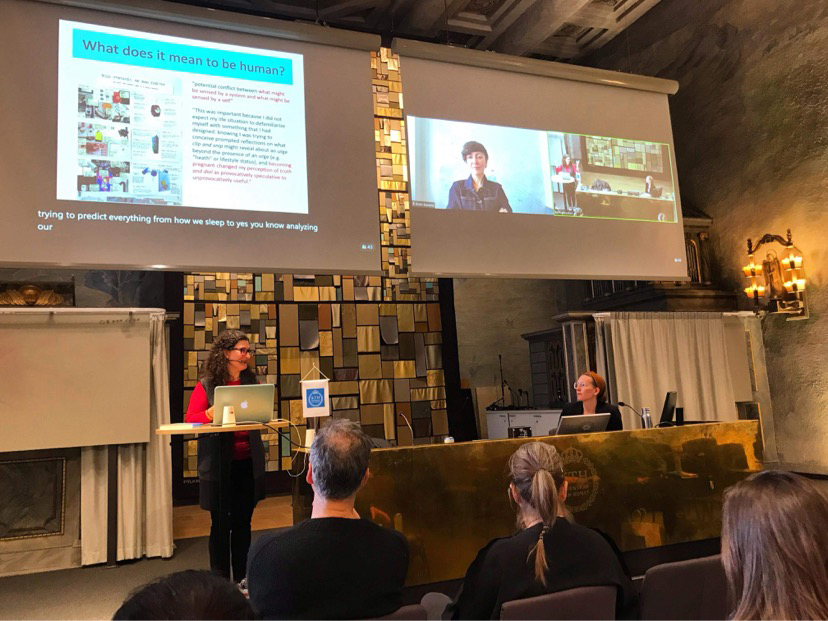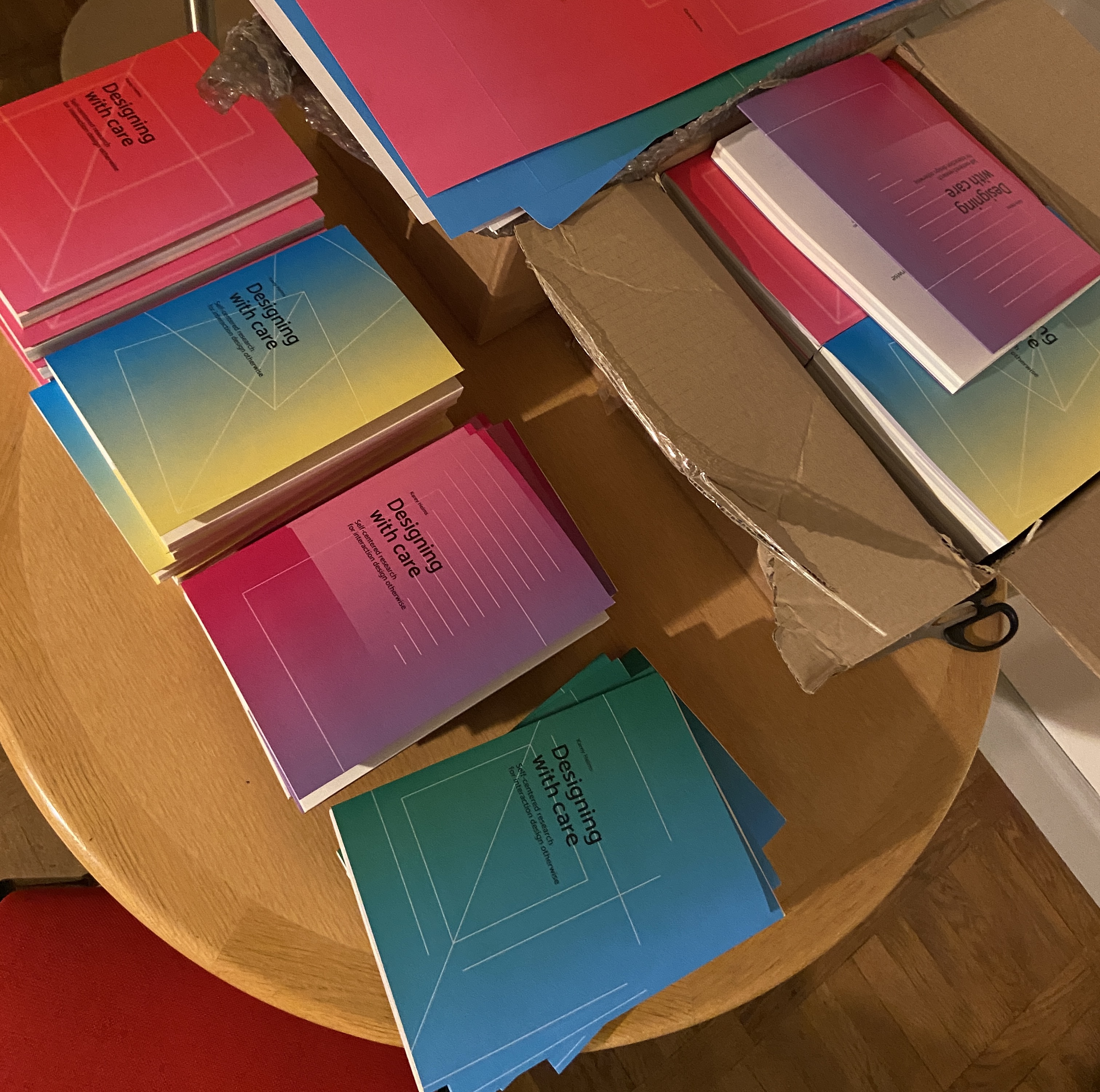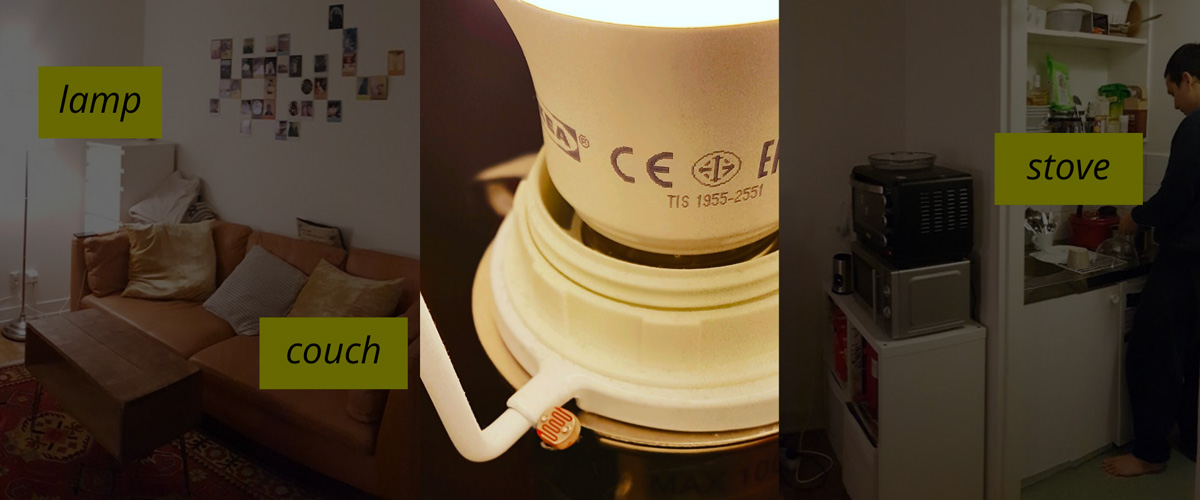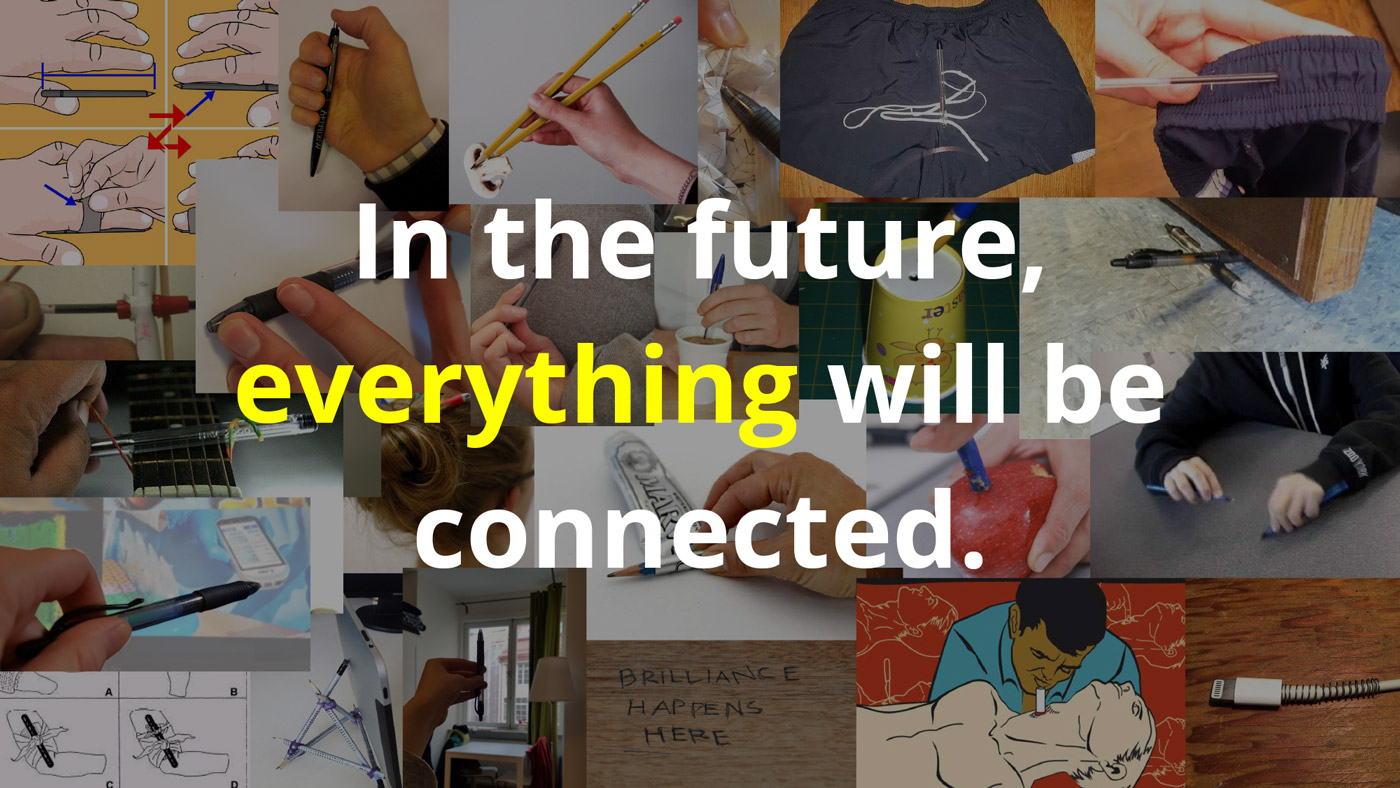Category: KTH
Dr. Helms
What a privilege on Monday to have my doctoral work presented by Laura Forlano, and deeply engaged with by her and committee Danielle Wilde, Elvin Karana, and Carl DiSalvo (and Martin Avila). Elated, exhausted, overwhelmed, overjoyed, tired, and energized are just a few of the ways I feel. So thankful for the incredible support from everyone near, far, in person, and online. ~ Dr. Helms

PhD defense!
On Feb 6th 13.00, I’ll be taking a brief intermission from parental leave 👶 to defend my thesis “Designing with care: Self-centered research for interaction design otherwise” ✨ Welcome to join: Kollegiesalen, Brinellvägen 8, Stockholm or on Zoom (https://kth-se.zoom.us/j/67699289253). Abstract below and PDF here!
Opponent: Laura Forlano
Committee: Danielle Wilde, Carl DiSalvo (virtual), Elvin Karana (virtual), Martin Avila

Designing with care: Self-centered research for interaction design otherwise
This dissertation is about the research program designing with care as a pathway towards interaction design otherwise amid a world in crisis. Considering how established ways of doing interaction design will change involves recognizing the role of digital materials in social injustice and systemic inequality. These concerns are inseparable from the material complexity of interactive experiences and their more-than-human entanglements in care. Through five design experiments, I explore everyday human care as wickedly attending to some care doings and not others, and an intimate and generous questioning of oneself as human.
I offer four contributions for interaction designers and design researchers. The first contribution is designing with care. This research program draws upon care ethics and posthumanism to establish four axioms: everyday, wickedness, intimacy, and generosity. Within this programmatic framework, the second contribution is definitions of wickedness and generosity as ethical stances that can be taken by designers and researchers. The third contribution is the synthesis of my four methodological approaches: auto-design, spatial orientations, leaky materials, and open speculations. Each is a generative and analytical pathway towards more sustainable and just futures. The fourth contribution is five careful designs as prototypes of what interaction design otherwise might be like: technologies of human waste, spying on loved ones, leaky breastfeeding bodies, scaling bodily fluids, and a speculative ethics.
From my research program and contributions, I discuss disciplinary resistances to suggest three possibilities for how I argue interaction design should change: engaging with mundane yet unrecognized topics, doing design work where the consequences would be present, and reconsidering how the formats of research publications could better reflect positionality. I then reflect upon the relevancy of self-centered research in moving beyond oneself for more sustainable worlds.
CHI 2022 – Publications
A little over a week ago, I had two papers published at the ACM CHI conference and a position paper shared at the workshop Feminist Voices about Ecological Issues in HCI. Check them out!
Karey Helms. 2022. A Speculative Ethics for Designing with Bodily Fluids. ACM Conference on Human Factors in Computing Systems Extended Abstracts (CHI 2022, alt.chi) New Orleans, LA, USA.
PDF, DOI, Video (8 min), Video (30 sec)
Pedro Sanches, Noura Howell, Vasiliki Tsaknaki, Tom Jenkins, and Karey Helms. 2022. Diffraction-in-action: Designerly Explorations of Agential Realism Through Lived Data. ACM Conference on Human Factors in Computing Systems (CHI 2022), New Orleans, LA, USA. (Best Paper Honorable Mention Award)
DOI, Video (8 min), Video (30 sec)
Karey Helms. 2022. Site-writing around Breastfeeding. ACM Conference on Human Factors in Computing Systems (CHI 2022, Position paper) Workshop “Feminist Voices about Ecological Issues in HCI”, New Orleans, LA, USA.
DIS 2017 – Accepted Works-in-Progress (PWiP)
Both very unexpected and exciting to have a work-in-progress accepted to DIS 2017 in Edinburgh. I wrote about an ongoing autobiographical design project that was started this spring along side a few other explorations to kick-start my PhD at KTH this year. Very thankful to Kia Höök who talked me through my insight at a KTH Interaction Design writer’s camp in March and the reviewers who gave great feedback on how to continue developing it into a full paper.

Leaky Objects: Implicit Information, Unintentional Communication (PDF)
This paper introduces the concept of leaky objects to describe this phenomenon in which shared objects unintentionally reveal implicit information about individual or collective users. This leaking of implicit information changes our individual interactions with objects to through objects, enabling expressive communication and ambiguous speculation. The aim of this paper is raise awareness of this phenomenon through an ongoing autobiographical design probe in which remote interpersonal communication through a connected object is being explored, and raise questions regarding the potential implications for designers.
Design Brief – Manuals of Misuse
Below is the design brief that I wrote for the master’s level course in which I am a Teaching Assistant. The course is Interaction Design as a Reflective Practice.

Design Brief
Technological forecasts often predict that someday in the future everything will be connected. What is everything? And why is connected so often synonymous with tangible interactions being transferred to mobile applications or voice-based assistants? Additionally, these solutions primarily focus on efficiency and automation, signaling a shift from engagement to a frictionless relationship with technology. Is this shift necessary, or do our physical things have overlooked abilities, hidden meanings or magical uses?
The project Manuals of Misuse investigates these questions by examining our everyday interactions with faceless objects and reimagining how they might be misused to playfully control or meaningfully communicate with other things, people or places.
You will do this by:
- Reflecting upon the intended interactions of an everyday object of your choice
What is the essential use of the object and the ideal scenarios of interactions? - Communicating how the object is meant to be used, interacted with and part of an ecosystem
What information is needed to communicate to a novice user, product partner, or manufacturer? - Investigating how the object is or could be misused – used for purposes not intended by the designer
What are the object’s properties and/or affordances that result in these misuses? - Generating novel design concepts of playful, meaningful or magical misuse
What modifications, interactions and technologies are required to make this possible? - Creating a stand-alone, multimedia experience that conveys your reimagined misuse
What is needed to communicate the essence of your concept and prompt further investigation?
Objectives
- Reflection: Upon our mundane, micro interactions with everyday objects. How to we use things and why do we use, or misuse, them? What can we learn from misuse and how does it inform how open or closed we design for appropriation?
- Communication: Of design intent, technical specifications and user experience to diverse audiences through various mediums.
- Playfulness: For engaged action and meaningful interaction.
- Documentation: For reflection and communication.
Industry to Academia, London to Stockholm
This week marks a big transition as I leave the complexities of enterprise UX at Zebra Technologies to pursue a PhD in Smart Implicit Interaction at KTH in Stockholm as part of a newly formed research group. My academic statement of intent below perhaps best expresses the culmination of my past experiences leading to my forthcoming journey. And the photo is of course just one of the many fond memories I will take with me.

Statement of Intent
“You think that because you understand ‘one’ that you must therefore understand ‘two’ because one and one make two. But you forget that you must also understand ‘and’.” ~ Sufi teaching story (Meadows, 2008)
Interests
On my first day of architecture school, we were asked to diagram where we come from and where we are now using a only a series of lines and dots on index cards. At the time, I was baffled by the task of reducing a complex, dynamic, and intimate answer into such simplistic, static, and impersonal elements. While this assignment ultimately ignited my interest in the pieces and processes of emergent systems and how the unique relationships between individual components inform and define the greater whole; more importantly, it cultivated analytical and divergent thinking. I learned how to isolate core components from a system, define explicit interactions in a space, situate functions within a context, and map parametric flows across time. Though eventually, my career pivoted from architecture to design as my intent transitioned from delight to meaning, and thus my thinking transformed from analytical to synthetic.
The primary differentiator between my experiences in architecture and design has been the latter’s focus on creative problem solving, or the convergence of disparate elements, activities, and intents to foster meaning. People have become the focus and embodied interaction the goal as I have strived to understand how space becomes place and appearance becomes presence. As an Interaction Designer, I design how people interact with, through, or without technology – an infinite and inclusive definition that ultimately focuses on people and prepositions, as it is the relationships that concern me. But as objects, environments, and worlds become ubiquitously intelligent, networked, and augmented, these relationships become increasingly dynamic, contextual, and intangible. I believe that negotiating these evolving relationships – to ultimately design meaningful new interaction modalities – is an exciting, challenging, and significant opportunity. Thus, I am interested in architecting the synthetic.
Pervasive and with unbounded potential, the “Internet of Things” is the key catalyst and instantiation of this paradigm shift towards implicit interactions. Moreover, as IoT infiltrates the mundane moments of our daily lives, it has the ability to transform our quality of life and achieve efficacious new futures from life-saving wearables to intelligent infrastructures. Though due to its systemic and embedded nature, both participative frameworks and contextual interventions are needed (as interaction is reciprocal), and thus both designs and the environments by which designers and users occupy, must be regarded. This duality necessitates divergent and convergent thinking, with a careful consideration of constraints, contexts, and intents. Therefore, through critical practice, ethnographic research, and situated prototypes, I aspire to explore what could be and what should be the intelligent dialogues of mediated, smart environments.
Capabilities
Over the past decade I have been afforded opportunities professionally, academically, and independently to cultivate the necessary skillset for the pursuit of a PhD in Interaction Design. Following the completion of my BS in Architecture, for over four years I was primarily self-employed as an Interaction Designer and Front-end Developer, working directly with clients from contract to concept to deployment. During this time, I was fortunate to work with a vast array of clients, expanding my formal digital design skills encompassing personas, user flows, information architecture, visual design, and UI development. Though more importantly, the empirical knowledge gained – pertaining to interpersonal and leadership skills, rigorous self-directed scheduling, and end-to-end digital product management and development – has been most invaluable.
My return to academia for my MFA in Interaction Design at Umeå University in 2012 was sparked by a desire to merge my physical and digital backgrounds within a formal user-centered education. My time in Umeå was marked by diverse and immersive collaborations with both peers and industry partners alike, who provided boundless intellectual stimulation while broadening my perspectives. I learned how to think critically and share imaginatively, perhaps best demonstrated in my speculative design thesis. Driven by a passion to critique and challenge society’s relationship with energy, I constructed a near future fictional society in which citizens are required to produce all the energy they desire to consume. Through liminal spaces and diegetic prototypes, I provoked polemical and productive dialogues, which were an engaging end to a wonderful graduate experience.
Following Umeå I moved to London and became a Senior Interaction Designer on the Innovation and Design Team at Zebra Technologies, an enterprise Internet of Things company. Within the constraints of business co-creation and the freedom of internal initiatives, my work investigates a product shift from isolated hardware and software to integrated systems and agents. In particular, I seek to design appropriate solutions at relevant fidelities that can enhance the cognitive and physical abilities of situationally disabled users in data-centric environments. For example, I am the Design Lead in a long-term co-creation project with a global transportation and logistics company seeking to improve organizational and workflow processes through custom 3D imaging technology and edge analytics. Besides traditional UX deliverables, my role includes ethnographic research, empathy mapping, stakeholder communication, service design, and a constant negotiation between implementable and transformational near future visions.
In addition to my role at Zebra, I actively engage in personal side projects which I playfully call “self-centered design.” Within these hypercritical explorations, I prototype manifestations of invisible interactions from the mundane moments of my daily life to gain insights into embodied interaction and socio-technical systems. Two ongoing projects are “Phygital Party Mode” and “Burrito.” The former is a phygital representation of online visitors’ interactions with my portfolio via Google Polymer, Firebase, Arduino, and Philips Hue technologies. Burrito is a manifestation of my marriage in the form of a bot that makes judgements on our relationship based on a mutually defined algorithm. Though perhaps a bit bonkers, both prototypes have resulted in instrumental insights that technically and creatively impact my professional development.
Motivation
My motivation to be a doctoral student is a combination of passion for the subject, drive to innovate in an immersive environment, desire to collaborate on a highly capable and motivated research team, and aspiration to contribute to academia via teaching. Throughout my educational background thus far, I have been fortunate to learn, collaborate, and contribute within competitive academic environments that seek and attain meaningful innovation. At both the University of Virginia and Umeå Institute of Design, I experienced firsthand the productive synthesis of cross-disciplinary participation and student-faculty engagement. These relationships were not only instrumental in my own development, but more importantly, contributed to the progress of meaningful experiences, emerging technology, and imaginative new futures. With diligent analysis and thoughtful synthesis, I would love to continue this trajectory at KTH with an inspiring team at a leading institution, and can guarantee that in addition to my credentials, I bring a healthy dose of gumption.
Meadows, Donella H. (2009). Thinking in Systems: a Primer. London, UK: Earthscan.